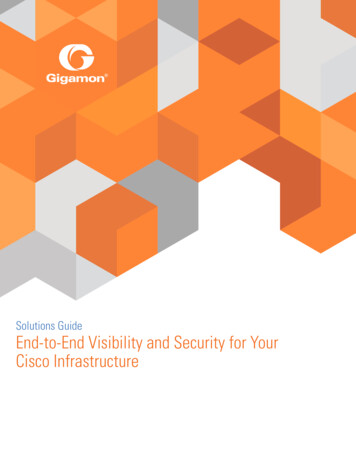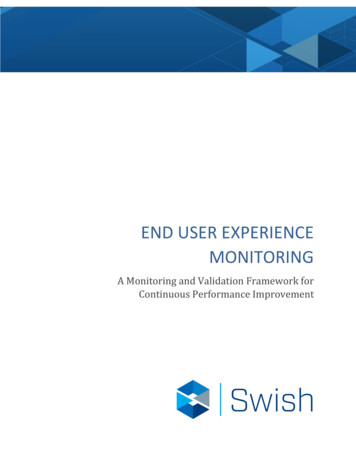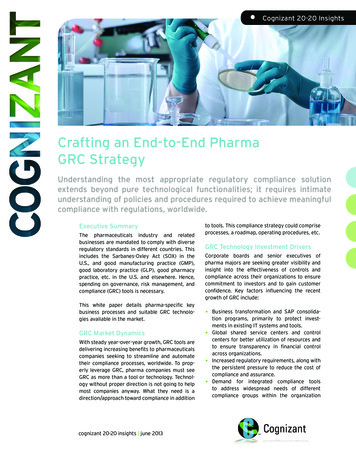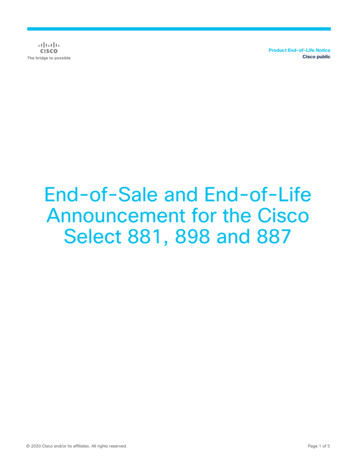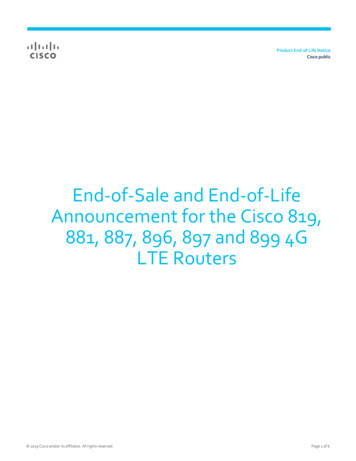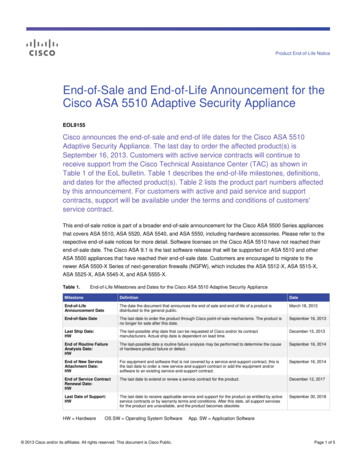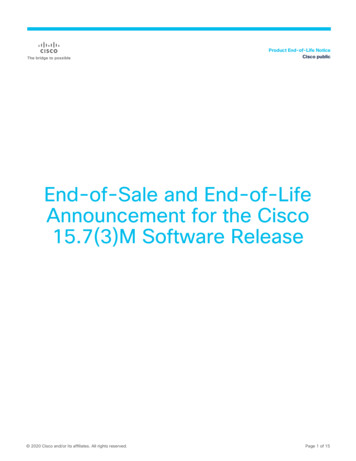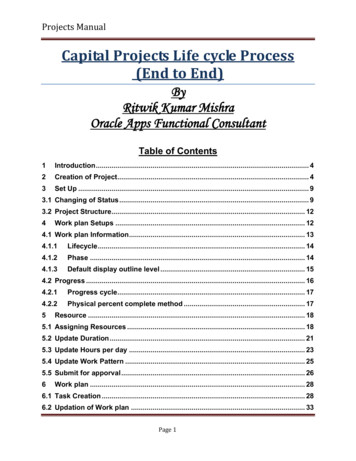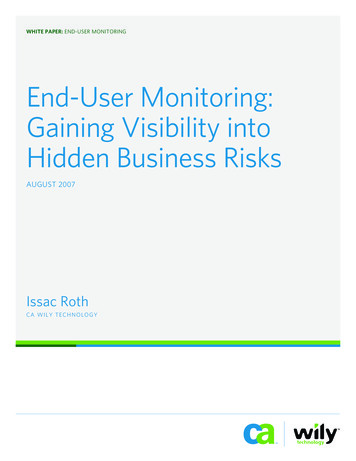
Transcription
white paper: END-USER MONITORINGEnd-User Monitoring:Gaining Visibility intoHidden Business Risksaugust 2007Issac Rothca wily technology
Table of ContentsExecutive Summarysection 612How CA Wily Can Helpsection 14IntroductionSupport Corporate InitiativesCritical Business Transactions Are Moving OnlineSection 7Traditional Management Tools Are Not Enoughsection 2Optimizing the User Experience with CA Wily CEM5The Need for Real-Time CustomerTransaction DataThe CA AdvantageAbout CA WilyBusiness Needs to KnowIT Needs to Knowsection 37Business BenefitsRegain Lost Customer VisibilityWork Collaboratively with ITsection 48User-Based Service-Level ManagementMeasure Real User Experiencesection 515Conclusion9IT BenefitsEnhance Existing Management ToolsHigher End-User Success RatesHigher Availability and PerformanceGreater ProductivityCopyright 2007 CA.All rights reserved. All trademarks, trade names, service marks and logos referenced herein belong to their respective companies.Back Cover
Executive SummaryChallengeThe increasing reliance on web-based applications has had significant unintendedconsequences. As customers, partners and employees rely on IT-supported applicationsto acquire products and services, business managers now have limited visibility intothe end-user experience, creating a blind spot that adds risk to their organization.Are essential services being delivered? Are transactions being fulfilled? Are criticalapplications compliant with service level agreements (SLAs)? Are end-user problemsdetected and resolved in a timely fashion? This new generation of web applicationsrequires a new approach to management that closely links IT and the Business.OpportunityThis paper discusses how organizations can regain visibility into the success of theironline transactions and the quality of the end-user experience. The focus is on themeaningful insight that monitoring an online transaction at the individual user levelprovides into the nature, severity and business impact of poor application performance.Whether they are external customers, suppliers, or employees, end-user monitoringcreates actionable, fact-based information that ensures web applications are fullyserving their purpose—from the customer and business points of view.BenefitsBy monitoring critical end-user business transactions as they move through the webapplication infrastructure, IT can share critical intelligence with business stakeholdersand better manage application performance and availability. In this way, the organizationcan work collaboratively to achieve common objectives: superior service delivery,end-user satisfaction and assurance of revenue streams.White paper: END-USER MONITORING
section 1IntroductionCritical Business Transactions Are Moving OnlineLeading organizations are migrating critical business functions to the web to reduce inefficienciesby removing the people and processes that separate customers from products or services.The advantages are clear: customers, partners, and employees can serve themselves, increasingrevenue while reducing costs.This increasing reliance on web-based applications has had significant unintended consequences.As customers, partners and employees rely on IT services, business managers now have limitedvisibility into the end-user experience, creating a blind spot that adds risk to their organization.Are essential services being delivered? Are transactions being carried out properly? Are criticalapplications compliant with service level agreements (SLAs)? Are end-user problems detectedand resolved in a timely fashion? What is the cost of poor web application performance?Traditional Management Tools Are Not EnoughTo answer these questions and reduce the risks associated with online service delivery,organizations need more than traditional monitoring and analysis based on averageperformance metrics or help desk call tracking. They need to implement effective end-usertransaction monitoring and managementThis paper discusses the necessity of monitoring end-user transactions for effectively measuringSLA compliance and for conducting prioritized problem solving based on the business impactof poor performing transactions. The paper also describes how end-user transaction monitoringbenefits multiple stakeholders in the organization. With effective monitoring in place, businessmanagers benefit from superior service delivery, higher rates of end-user satisfaction andimproved revenue streams. For IT, end-user monitoring provides an end-to-end transactionview that enables the IT team as a whole to work collaboratively to solve problems and achieveperformance and availability goals from the user point of view. white paper: END-USER MONITORING
section 2The Need for Real-Time Customer Transaction DataVisibility into the online end-user experience is critical for both the business side and theIT side of an organization.Business Needs to Know: WHICH end-users are affected by any slowdowns or transaction problems? WHAT is happening now? How many transactions have succeeded or failed? The scaleof service problems cannot be simply measured in the number of help desk calls. HOW LONG does it take to complete a transaction? When an end-user complainsthat an application is slow, what does “slow” really mean? WHAT is the business impact from service problems? This includes reduced revenues,damage to brand and increased end-user frustration.IT Needs to Know: WHAT exactly is the problem? Can we find out before the call center escalates the issue?Are we recording the right metrics so we can accurately analyze the problem? WHY is the problem happening? Can we see a specific impact across the infrastructure?Which tier? WHERE should we direct resources to solve the problem? HOW should we prioritize problems, based on business goals and SLAs?Visibility into online transactions is complicated by the increasing complexity of today’sheterogeneous, SOA-based web application environments. As illustrated in Figure Abelow, each individual transaction follows a complex path through a large numberof applications, servers, networks and other elements across the application infrastructureand over the Internet. The applications themselves are increasingly complex, and eachindividual transaction involves multiple steps and procedures.figure Atypical end-to-end transactionToday’s online transactions musttraverse extremely complexenvironments that involve anincreasing number of processesand uterFirewallSwitchLoadBalancerMainframe DatabaseWebServersPortalApplicationsEnd UserWebServicesDatabases3 rd PartyApplicationsWhite paper: END-USER MONITORING
Multiply this complexity by the increasing number of end-users and application transactions,and it comes as no surprise that IT professionals are struggling to manage and control thedelivery of essential business processes and the SLAs that govern them.In a recent CA Wily Industry Benchmark Survey, respondents reported that the time requiredto identify incidents is a serious and persistent challenge, typically 5-10 hours. While mostproblems are solved in a day, fully 30 percent are not solved the same day. The respondentsalso stated that when problems are reactively identified by multiple end-user complaints,they take longer to resolve. And, when problems are reactively identified by multiple end-usercomplaints, they take longer to resolve.figure blittle issues add upMany small issues can addup to a serious degradationin :0014:0015:0016:00% availableWeb Server99%J2EE Server99%MQ Server99.9%Database99.9%CICS99.999%Siebel99.9%End User80%Unavailable or slowAvailable, performantFigure B above highlights how visibility is hampered in a complex, composite applicationenvironment where multiple stakeholders are expected to contribute to applicationavailability using multiple tools. In a traditional performance monitoring system whereindividual components are viewed as silos, each management tool might be able to report99% or better availability. However, with the complexity of today’s systems, a large numberof little issues can quickly impact the end-user experience, even though individual areasreport no significant problems.This situation is fundamentally a matrix problem. How does IT ensure accountabilityin an environment where each person or area can, with justification, deny any responsibilityfor a problem? This lack of accountability can lead not only to unexpected service problemsbut also to confusion and finger-pointing when issues need to be identified and resolved. white paper: END-USER MONITORING
With end-user transaction monitoring, you can measure the cumulative impact of performanceproblems across the infrastructure supporting the business process. Furthermore, the datacollected will better enable IT to determine the scope of the problem and quickly resolveit—before the customer call center is flooded with complaints.section 3Business BenefitsRegain Lost Customer VisibilityA specific example illustrates the business benefits of end-user transaction monitoring.In the days before web-based transactions, Warren, one of the premium customersof a brokerage firm, would drop by its retail location to execute a “buy stock” transaction.When working face-to-face, the broker knew immediately when Warren’s transactionrequest had been submitted successfully, both from the business and the customer viewpoint.With today’s web-based transactions however, the physical brokerage is disconnected fromthe online process and the broker does not know the success or quality of the transaction.What happens if Warren is having a problem submitting his “buy” transaction and receivesthe message, “Please try again” after every attempt? Did the brokerage receive Warren’s buyorder? How long did it take to complete Warren’s transaction? Did Warren receive the servicelevel he expected? Because the brokerage application is now the first line of communicationwith customer, these are questions that IT and business stakeholders must know howto answer in every instance, whether there is a problem or not.By monitoring all buy transactions through an end-user transaction monitoring solution,IT gains immediate visibility into critical factors that the business needs to know: whois experiencing the problem (Warren), the type of customer (premium), the transactionhe is executing (buy), the type of problem he is experiencing (unable to submit request),and the business impact of the problem (lost trading commission).Work Collaboratively with ITWith insight gained from an end-user transaction monitoring solution, IT then quicklycommunicates this information to the business which, in turn, proactively reaches outto Warren before he calls the support center. IT uses this information to identify the scopeof the problem (Are all premium customers affected?), diagnose the problem (Whereis the performance bottleneck?) and resolve the problem once the component is identified.Traditionally, the business has not relied on IT to provide this type of real-time insightinto user experiences. IT had a direct, one-to-one relationship with the business. Businesspeople were the primarily users of IT systems and were IT’s “customers.” Further, ITtranslated business’s requirements into the language of IT and it wasn’t necessary for businessto know that language—they only needed to know whether the systems they needed wereup and running properly. While owning customer relationships might be an unfamiliar rolefor IT, monitoring all web-based transactions and gaining insight into the end-user experienceenables IT to partner with the business and provide the critical end-user transaction visibilitynecessary to maintain the highest levels of customer satisfaction, employee productivity,and revenue streams.White paper: END-USER MONITORING
SECTION 4User-Based Service-Level ManagementMeasure Real User ExperienceProperly designed and implemented, an effective end-user transaction monitoring solutionprovides a highly granular, user-based perspective for managing SLAs based on criticalend-user activities such as login, account summary and buy transactions at the businessprocess level. The ability to group users based on a variety of criteria and capture performancemetrics down to the transaction component level makes it possible to accurately measureactual user experience against SLAs and report compliance in a business context that businessstakeholders will understand.In addition, a robust monitoring solution should be able to provide more than traditional“average performance” metrics, which ignore outliers and do not give an accurate representationof overall online end-user experiences. These metrics also fundamentally ignore the impactof incidents on individual users by only providing aggregate statistics and overall system health.In short, an effective end-user transaction monitoring solution should support disciplined SLAmanagement based on: Deep, end-to-end transaction visibility at both the business process and component level Correlation of end-user SLAs with system-wide SLAs/OLAs Flexible SLA reporting specific to different user groups Better understanding of the relationship between backend system downtime andthe end-user experience Deep integration with an SLA management tool to model monitored business processesagainst established business SLAs Deep integration with a Service Desk to ensure trouble tickets are triggered and prioritizedbased on SLAs white paper: END-USER MONITORING
figure csla scorecardExample of scorecard showingbusiness process success againstservice level agreements.SECTION 5IT BenefitsEnhance Existing Management ToolsAn end-user transaction monitoring tool enables IT to enhance existing managementdisciplines by adding deep visibility into end-users’ experiences, the health and availabilityof critical business processes, and the impact of the application infrastructure performanceon SLAs. As a result, IT can work more closely with business, providing better data andconsistent, comprehensive reports that demonstrate how IT is serving customers in alignmentwith business goals.An effective end-user transaction monitoring product provides IT with the following benefits:Higher End-User Success RatesReal end-user monitoring enables IT to track all critical user transactions on a 24/7basis and set proactive alerts that warn of out-of-bounds performance conditions beforecustomer SLAs are compromised. Once alerted, support can prioritize the problemsbased on the business process, number and type of user impacted, and quickly directthe problems to the correct department for resolution before additional users experiencethe same problem.White paper: END-USER MONITORING
Higher Availability and PerformanceReal-time transaction monitoring enables IT to detect problems that affect customersbefore the support center gets swamped with user calls. IT operations can quickly understandwho is impacted, what the cost to the business is, and why the problem arose. In addition,IT can build a history of performance for baselining and for predicting future problems.Based on this information, applications can become highly available and better performingover time.Greater ProductivityEnd-user and business transaction monitoring provides the Business and IT with a commonview, tool set and language to better understand and enhance the customer experience.The IT team can provide the business with the information necessary to proactively reachout to affected users while the different IT groups can collaborate on problem solving usinga single set of performance data. The ability of a robust end-user monitoring solution toinstantly diagnose the problem tier streamlines and accelerates the resolution process.figure dautomatic diagnosisMonitoring key business processesfrom the end-user viewpoint aidsproblem diagnosis.Furthermore, an end-user transaction monitoring solution improves collaboration amongIT stakeholders, delivering the following key benefits for each area of IT management.10 white paper: END-USER MONITORING
figure eEvery team within IT can benefitfrom end-user monitoring.empower your it teamroleadvantagebenefitApplication ManagersIncreasing efficiencyby assigning the problemto the right person.When end-users have issues,application managers can drilldown immediately to root causecomponent. They can alsomeasure the performance andimpact of application outagesand quality lapses.Systems ManagersPrioritizing problemresolution and increasingefficiencies.When end-users have issues,systems managers can drill downinstantly into the system that servedtheir requests. Managers canalso dispatch end-user problemsto the right set of systemsmanagers immediately.Help Desk ManagersEnhancing servicewith real-time,user-specific data.When a user calls, the help deskmanager can immediately lookup any application issues the userhas had in the past, based on theirname or other identifiers.Additionally, an end-user monitoringtool can proactively open ticketsbefore users call.Network ManagersImproving network problemresolution based on theend-user perspective.When network performancefluctuates, end-user monitoring letsnetwork managers know exactlywhich transactions and which usersare being affected and determinewhether the network is at fault.White paper: END-USER MONITORING 11
SECTION 6How CA Wily Can HelpCA Wily Customer Experience Manager (CEM) is a leading real-time end-user transactionmonitoring product. Supporting multiple applications, procedures and technologies acrossthe infrastructure, this product helps optimize the end-user experience by allowing IT teams to: DETECT AND AGGREGATE transaction errors and performance problems PRIORITIZE incidents based on business impact QUICKLY dispatch problem for resolution ESTABLISH, TRACK AND REPORT on SLAsOptimizing the User Experience with CEMCEM can detect when an end-user experiences a performance problem or transaction error.Alerts can be generated based on specific errors and thresholds for groups of end-users,business transactions, or groups of end-users for a particular business transaction.Once a transaction violates a threshold, CEM will capture it and aggregate similar defectivetransactions into an incident.CEM calculates the business impact from incidents based on the criticality of a specificbusiness transaction, the importance of the users involved, and the severity of the problem.Once a certain business impact level is reached, CEM automatically triggers evidencecollection from CA Wily Introscope , the industry-leading application performancemanagement tool, as well as routers, switches, and other infrastructure components. Thissnapshot of evidence aids problem resolution since it is done immediately and in the contextof the end-user’s problems.Based on SLAs set for end-user transactions, such as number of users impacted or rateof defects, an incident in CEM will automatically create a helpdesk ticket. With out-of-the-boxintegration with CA Unicenter Service Desk the ticket is created at the specified request areain Service Desk complete with a URL link to CEM and Introscope triage and diagnosticinformation in the application infrastructure supporting the transaction. The help deskrepresentative can immediately access critical information about the nature, severityand business impact of the incident and provide root-cause information to applicationsupport specialists.The specialist can then drill down into CEM’s SmartChart to quickly troubleshoot the problem.SmartChart graphically depicts CEM’s predictive analysis of the infrastructure tier most likelyto have caused the problem based on the number and variability of defects in each tier foreach business transaction. If necessary, the specialist can drill-down with one click to furtherisolate issues based on time
By monitoring critical end-user business transactions as they move through the web application infrastructure, It can share critical intelligence with business stakeholders and better manage application performance and availability. In this way, the organization can work collaboratively
